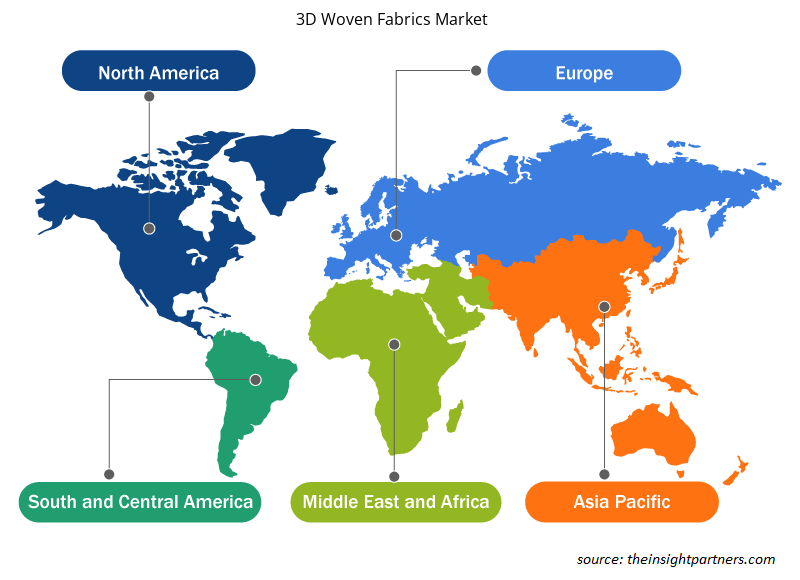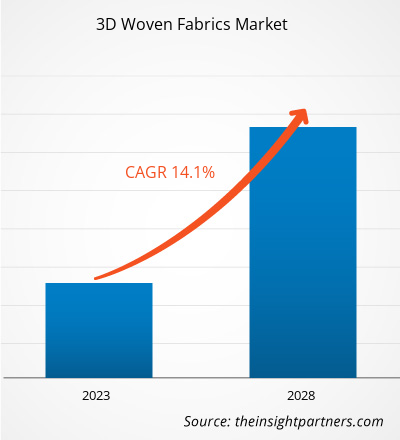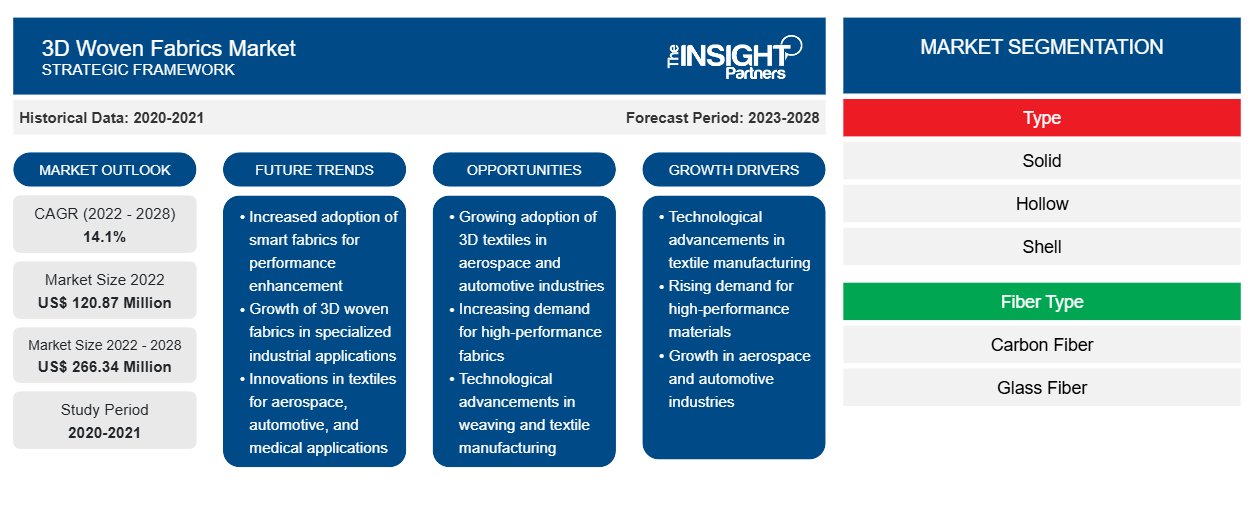[Informe de investigación] Se espera que el tamaño del mercado de tejidos 3D crezca de US$ 120,87 millones en 2022 a US$ 266,34 millones en 2028; se estima que crecerá a una CAGR del 14,1% de 2022 a 2028.
Los tejidos 3D son livianos en comparación con la mayoría de las maderas y metales. La propiedad liviana de los tejidos 3D hace que su uso sea importante en aeronaves y automóviles, donde un menor peso ofrece una mejor eficiencia de combustible. Hoy en día, los diseñadores de aviones están muy preocupados por el peso, ya que al reducir el peso de una aeronave se reduce la cantidad de combustible que necesita y aumenta la velocidad que puede alcanzar. Además, los tejidos 3D resisten los daños causados por el clima y los productos químicos agresivos. Se pueden moldear en formas complicadas con mayor facilidad que la mayoría de los demás materiales.
En 2022, Europa tuvo la mayor participación en los ingresos del mercado de tejidos 3D del mercado mundial de tejidos 3D. La demanda de tejidos 3D en Europa está aumentando debido al aumento de las actividades de I+D con respecto a la utilización de tejidos 3D en industrias de uso final como la aeronáutica, la automoción, la construcción y muchas otras. Los tejidos 3D en Europa tienen el potencial de crear oportunidades de negocio, exportación y aplicaciones de fabricación avanzadas para las industrias aeroespacial y automotriz en la región. Esto ha dado lugar a un rápido aumento de la popularidad de los tejidos 3D en Europa. Según la Comisión Europea, la Unión Europea invirtió aproximadamente 103 000 millones de dólares en el programa de financiación de la investigación y la innovación (Horizon 2021) entre 2021 y 2027. Se trataba de financiación para el desarrollo de textiles avanzados utilizados en los sectores del transporte y la aeronáutica. Todos estos factores contribuyen positivamente al crecimiento del mercado de tejidos 3D en la región.
Personalice este informe según sus necesidades
Obtendrá personalización en cualquier informe, sin cargo, incluidas partes de este informe o análisis a nivel de país, paquete de datos de Excel, así como también grandes ofertas y descuentos para empresas emergentes y universidades.
-
Obtenga las principales tendencias clave del mercado de este informe.Esta muestra GRATUITA incluirá análisis de datos, desde tendencias del mercado hasta estimaciones y pronósticos.
Impacto de la pandemia de COVID-19 en el mercado de tejidos 3D
Industrias como la automotriz, aeroespacial, construcción y edificación, y defensa y militar han sido las principales contribuyentes a la demanda de tejidos 3D. En 2020, estas industrias tuvieron que ralentizar sus operaciones debido a las interrupciones en la cadena de valor causadas por el cierre de las fronteras nacionales e internacionales. La escasez de mano de obra resultó en la desaceleración de las operaciones de producción y distribución de tejidos 3D. Las interrupciones en la cadena de suministro global y el cierre de las instalaciones de producción de resina provocaron un fuerte aumento en los precios de los tejidos 3D. Los cierres impuestos por diferentes países en 2020 obstaculizaron la capacidad de las industrias para mantener los niveles de inventario. Además, las medidas sanitarias y otras precauciones de COVID-19 redujeron significativamente la capacidad de producción, creando una escasez de inventario de tejidos 3D. Sin embargo, en 2021, el mercado global comenzó a recuperarse de las pérdidas sufridas en 2020 cuando los gobiernos de diferentes países anunciaron la relajación de las restricciones sociales. Además, el aumento de las tasas de vacunación contribuyó a mejorar las condiciones generales en diferentes países, lo que generó entornos propicios para el progreso industrial y comercial. Además, el aumento de las capacidades de producción en la industria automotriz y otras industrias en Europa y América del Norte resultó en un aumento de la demanda de tejidos 3D en 2021.
Perspectivas del mercado
Demanda creciente de tejidos tridimensionales en la industria automotriz y aeronáutica
Los materiales avanzados son cruciales para aumentar la economía de combustible de los automóviles modernos al tiempo que garantizan la seguridad y el rendimiento. La sustitución de componentes de hierro fundido y acero tradicionales por materiales ligeros, como tejidos 3D de alta resistencia, reduce el peso de la carrocería y el chasis de un vehículo, lo que reduce el consumo de combustible de un vehículo. Además, los tejidos 3D son adecuados para la fabricación de componentes interiores no estructurales, respaldos de asientos, revestimientos de techo, paneles interiores y tableros de instrumentos. El uso de compuestos reforzados con fibras naturales está aumentando en aplicaciones aeronáuticas debido a la legislación y las regulaciones que obligan a los fabricantes a utilizar materiales sostenibles y reciclados para fabricar vehículos ligeros y de bajo consumo de combustible. Además, los fabricantes de aeronaves están haciendo esfuerzos para ampliar las estructuras termoplásticas primarias en aviones comerciales y de negocios. Han sido los primeros en adoptar termoplásticos reforzados con fibras largas.
Tipo de información
Según el tipo, el mercado mundial de tejidos 3D se segmenta en sólido, hueco, concha y nodal. La cuota de mercado mundial de tejidos 3D para el segmento sólido fue la más grande en 2022. El sólido 3D se refiere a arquitecturas tejidas con secciones transversales sólidas, ya sea en un panel ancho o en una preforma en forma de red. Es una estructura que comprende secciones integradas de múltiples paredes en las direcciones del ancho y el grosor de la tela, que definen una forma de sección transversal sin ninguna abertura tipo túnel en la dirección de la longitud de la tela. El sólido 3D consta de entrelazados multicapa, ortogonales y angulares. El ortogonal se basa en hilos rectos. Se utilizan hilos de urdimbre y trama para gestionar el grosor de la tela. Esta estructura tiene una fracción de volumen mayor que otras. El entrelazado angular se basa en capas individuales. Cada capa es diferente de otra. Las estructuras sólidas 3D varían de dos a cuatro capas. Se espera que el segmento sólido crezca significativamente y represente el crecimiento del tamaño del mercado de tejidos 3D.
Los actores clave que operan en el mercado global de tejidos 3D incluyen a Textum OPCO LLC, Tex Tech Industries Inc, Sigmatex (UK) Ltd, 3D Woven SaRL, Tantra Composite Technologies Pvt Ltd, U-Long High Tech Textile Co Ltd, TEAM Inc, Changzhou Bolong Three Dimensional Composites Co Ltd, Topweaving New Material Tech Co Ltd y China Beihai Fiberglass Co Ltd. Los actores que operan en el mercado global de tejidos 3D se enfocan en proporcionar productos de alta calidad para satisfacer la demanda de los clientes. También se centran en estrategias como inversiones en actividades de investigación y desarrollo y lanzamientos de nuevos productos.
Perspectivas regionales del mercado de tejidos 3D
Los analistas de Insight Partners explicaron en detalle las tendencias y los factores regionales que influyen en el mercado de tejidos 3D durante el período de pronóstico. Esta sección también analiza los segmentos y la geografía del mercado de tejidos 3D en América del Norte, Europa, Asia Pacífico, Oriente Medio y África, y América del Sur y Central.

- Obtenga datos regionales específicos para el mercado de tejidos 3D
Alcance del informe de mercado de tejidos 3D
| Atributo del informe | Detalles |
|---|---|
| Tamaño del mercado en 2022 | US$ 120,87 millones |
| Tamaño del mercado en 2028 | US$ 266,34 millones |
| CAGR global (2022-2028) | 14,1% |
| Datos históricos | 2020-2021 |
| Período de pronóstico | 2023-2028 |
| Segmentos cubiertos |
Por tipo
|
| Regiones y países cubiertos |
América del norte
|
| Líderes del mercado y perfiles de empresas clave |
|
Densidad de actores del mercado de tejidos 3D: comprensión de su impacto en la dinámica empresarial
El mercado de tejidos 3D está creciendo rápidamente, impulsado por la creciente demanda de los usuarios finales debido a factores como la evolución de las preferencias de los consumidores, los avances tecnológicos y una mayor conciencia de los beneficios del producto. A medida que aumenta la demanda, las empresas amplían sus ofertas, innovan para satisfacer las necesidades de los consumidores y aprovechan las tendencias emergentes, lo que impulsa aún más el crecimiento del mercado.
La densidad de actores del mercado se refiere a la distribución de las empresas o firmas que operan dentro de un mercado o industria en particular. Indica cuántos competidores (actores del mercado) están presentes en un espacio de mercado determinado en relación con su tamaño o valor total de mercado.
Las principales empresas que operan en el mercado de tejidos 3D son:
- Texto OPCO LLC
- Industrias de tecnología tex inc.
- Sigmatex (Reino Unido) Ltd
- Tejido 3D SaRL
- Tantra Composite Technologies Pvt Ltd
Descargo de responsabilidad : Las empresas enumeradas anteriormente no están clasificadas en ningún orden particular.

- Obtenga una descripción general de los principales actores clave del mercado de tejidos 3D
Informe Destacado
- Tendencias progresivas de la industria en el mercado de tejidos 3D para ayudar a los actores a desarrollar estrategias efectivas a largo plazo
- Estrategias de crecimiento empresarial adoptadas por los mercados desarrollados y en desarrollo
- Análisis cuantitativo del mercado de tejidos 3D de 2020 a 2028
- Estimación de la demanda mundial de tejidos tridimensionales
- Análisis de las cinco fuerzas de Porter para ilustrar la eficacia de los compradores y proveedores que operan en la industria
- Avances recientes para comprender el escenario competitivo del mercado
- Tendencias y perspectivas del mercado, así como factores que impulsan y restringen el crecimiento del mercado de tejidos 3D
- Asistencia en el proceso de toma de decisiones destacando las estrategias de mercado que sustentan el interés comercial, lo que conduce al crecimiento del mercado.
- El tamaño del mercado de tejidos 3D en varios nodos
- Descripción detallada y segmentación del mercado, así como la dinámica de la industria de tejidos 3D
- El tamaño del mercado de tejidos 3D en varias regiones con oportunidades de crecimiento prometedoras
Mercado mundial de tejidos 3D
Según el tipo, el mercado de tejidos 3D se segmenta en sólidos, huecos, con carcasa y nodales. Según el tipo de fibra, el mercado global de tejidos 3D se segmenta en fibra de carbono , fibra de vidrio y otros. Según la aplicación, el mercado de tejidos 3D se segmenta en balística, aeronáutica, transporte, construcción y edificación, y otros.
Perfiles de empresas
- Texto OPCO LLC
- Industrias de tecnología tex inc.
- Sigmatex (Reino Unido) Ltd
- Tejido 3D SaRL
- Tantra Composite Technologies Pvt Ltd
- U-Long Alta Tecnología Textil Co Ltd
- EQUIPO Inc.
- Changzhou Bolong Compuestos tridimensionales Co., Ltd.
- Topweaving Nuevo Material Tech Co Ltd
- China Beihai Fibra de vidrio Co., Ltd.
- Análisis histórico (2 años), año base, pronóstico (7 años) con CAGR
- Análisis PEST y FODA
- Tamaño del mercado, valor/volumen: global, regional y nacional
- Industria y panorama competitivo
- Conjunto de datos de Excel
Informes recientes
Informes relacionados
Testimonios
Razón para comprar
- Toma de decisiones informada
- Comprensión de la dinámica del mercado
- Análisis competitivo
- Información sobre clientes
- Pronósticos del mercado
- Mitigación de riesgos
- Planificación estratégica
- Justificación de la inversión
- Identificación de mercados emergentes
- Mejora de las estrategias de marketing
- Impulso de la eficiencia operativa
- Alineación con las tendencias regulatorias























 Obtenga una muestra gratuita para - Mercado de tejidos 3D
Obtenga una muestra gratuita para - Mercado de tejidos 3D